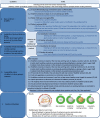Development of the 'Canteen Scan': an online tool to monitor implementation of healthy canteen guidelines
- PMID: 30200919
- PMCID: PMC6131796
- DOI: 10.1186/s12889-018-5974-8
Development of the 'Canteen Scan': an online tool to monitor implementation of healthy canteen guidelines
Abstract
Background: To improve the availability and accessibility of healthier food and drinks in schools, sports and worksites canteens, national Guidelines for Healthier Canteens were developed by the Netherlands Nutrition Centre. Until now, no tool was available to monitor implementation of these guidelines. This study developed and assessed the content validity and usability of an online tool (the 'Canteen Scan') that provides insight into and directions for improvement of healthier food products in canteens.
Methods: The Canteen Scan was developed using a three-step iterative process. First, preliminary measures and items to evaluate adherence to the guidelines were developed based on literature, and on discussions and pre-tests with end-users and experts from science, policy and practice. Second, content validity of a paper version of the Canteen Scan was assessed among five end-users. Third, the online Canteen Scan was pilot tested among end-users representing school canteens. Usability was measured by comprehensibility, user-friendliness, feasibility, time investment, and satisfaction.
Results: The content validity of the Canteen Scan was ensured by reaching agreement between stakeholders representing science, policy and practice. The scan consists of five elements: 1) basic conditions (e.g. encouragement to drink water and availability of policy regarding the guidelines), 2) product availability offered on displays (counter, shelf) and 3) in vending machines, 4) product accessibility (e.g. promotion and placement of products), and 5) an overall score based on the former elements and tailored feedback for creating a healthier canteen. The scan automatically classifies products into healthier or less healthy products. Pilot tests indicated good usability of the tool, with mean scores of 4.0-4.6 (5-point Likert scale) on the concepts comprehensibility, user-friendliness and feasibility.
Conclusion: The Canteen Scan provides insight into the extent to which canteens meet the Dutch Guidelines for Healthier Canteens. It also provides tailored feedback to support adjustments towards a healthier canteen and with the scan changes over time can be monitored. Pilot tests show this tool to be usable in practice.
Keywords: Canteens; Content validity; Digital assessment; Environment; Food; Nutrition policy; Public setting.
Conflict of interest statement
Ethics approval and consent to participate
The development of the Canteen Scan was part of a larger study, which was approved by the Medical Ethical Committee of the VU University Amsterdam (Nr. 2015.331). During the study recruitment, all participants were informed about the research aim, procedures and data use. All participants gave their verbal informed consent.
Competing interests
The authors declare that they have no competing interests.
Publisher’s Note
Springer Nature remains neutral with regard to jurisdictional claims in published maps and institutional affiliations.
Figures
Similar articles
-
Implementation of Guidelines for Healthier Canteens in Dutch Secondary Schools: A Process Evaluation.Int J Environ Res Public Health. 2019 Nov 15;16(22):4509. doi: 10.3390/ijerph16224509. Int J Environ Res Public Health. 2019. PMID: 31731619 Free PMC article.
-
What Do Secondary Schools Need to Create Healthier Canteens? The Development of an Implementation Plan.Front Public Health. 2021 Jun 23;9:683556. doi: 10.3389/fpubh.2021.683556. eCollection 2021. Front Public Health. 2021. PMID: 34249845 Free PMC article.
-
Development and Evaluation of the Implementation of Guidelines for Healthier Canteens in Dutch Secondary Schools: Study Protocol of a Quasi-Experimental Trial.Front Public Health. 2019 Sep 6;7:254. doi: 10.3389/fpubh.2019.00254. eCollection 2019. Front Public Health. 2019. PMID: 31555634 Free PMC article.
-
School meals in Catalonia: surveillance and quality control.Public Health Nutr. 2001 Dec;4(6A):1339-41. doi: 10.1079/phn2001214. Public Health Nutr. 2001. PMID: 11918476 Review.
-
Dietary guidelines in singapore.Asia Pac J Clin Nutr. 2011;20(3):472-6. Asia Pac J Clin Nutr. 2011. PMID: 21859669 Review.
Cited by
-
Implementation of Guidelines for Healthier Canteens in Dutch Secondary Schools: A Process Evaluation.Int J Environ Res Public Health. 2019 Nov 15;16(22):4509. doi: 10.3390/ijerph16224509. Int J Environ Res Public Health. 2019. PMID: 31731619 Free PMC article.
-
What Do Secondary Schools Need to Create Healthier Canteens? The Development of an Implementation Plan.Front Public Health. 2021 Jun 23;9:683556. doi: 10.3389/fpubh.2021.683556. eCollection 2021. Front Public Health. 2021. PMID: 34249845 Free PMC article.
-
The Impact of a Gradual Healthier Assortment among Vocational Schools Participating in a School Canteen Programme: Evidence from Sales and Student Survey Data.Int J Environ Res Public Health. 2020 Jun 17;17(12):4352. doi: 10.3390/ijerph17124352. Int J Environ Res Public Health. 2020. PMID: 32560545 Free PMC article.
-
The Effect of Supportive Implementation of Healthier Canteen Guidelines on Changes in Dutch School Canteens and Student Purchase Behaviour.Nutrients. 2020 Aug 12;12(8):2419. doi: 10.3390/nu12082419. Nutrients. 2020. PMID: 32806649 Free PMC article. Clinical Trial.
-
Background and evaluation design of a community-based health-promoting school intervention: Fit Lifestyle at School and at Home (FLASH).BMC Public Health. 2019 Jun 20;19(1):784. doi: 10.1186/s12889-019-7088-3. BMC Public Health. 2019. PMID: 31221106 Free PMC article. Clinical Trial.
References
-
- WHO . World statistics 2016: monitoring health for the SDG's. Geneva: WHO press; 2016.
MeSH terms
LinkOut - more resources
Full Text Sources
Other Literature Sources



